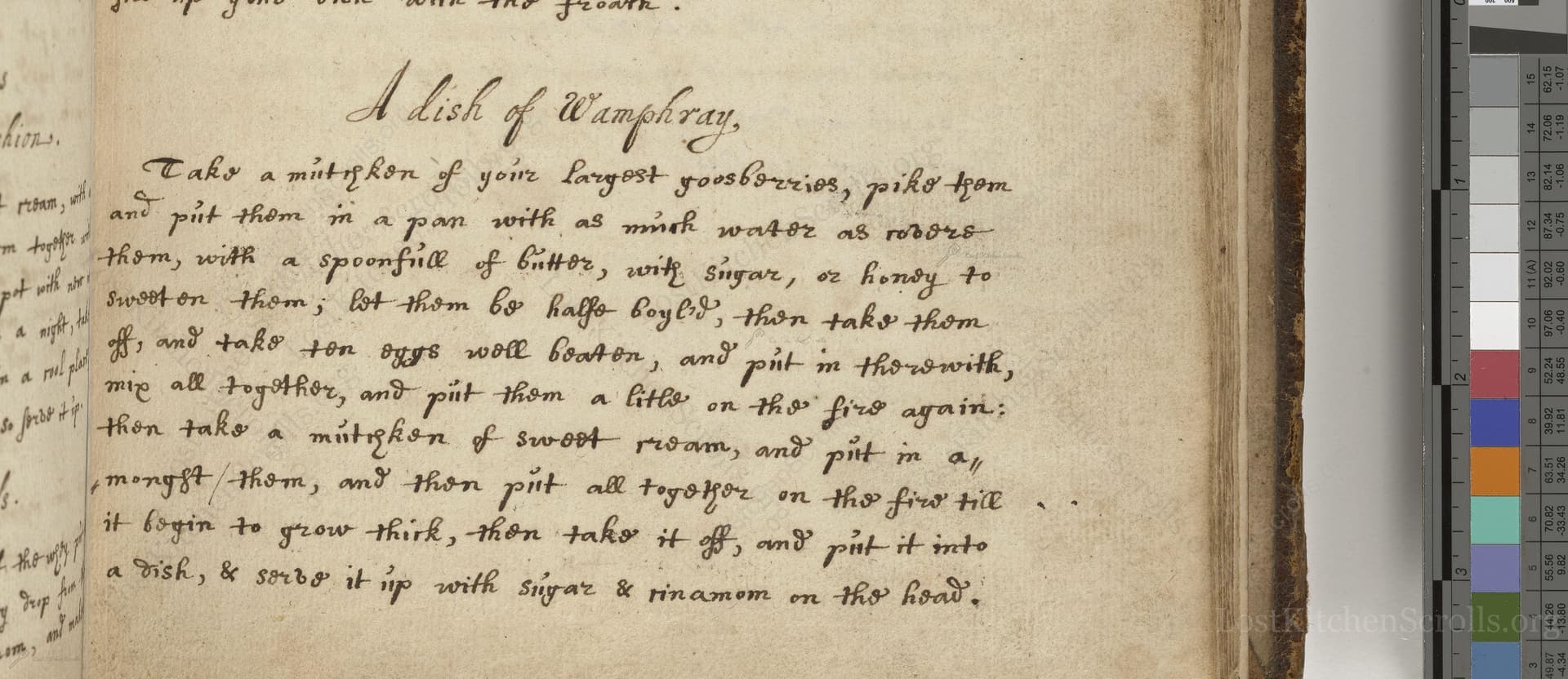A Dish Of Wamphray
From the treasured pages of Receipt book
Unknown Author

A Dish Of Wamphray
"Take a mutchkon of your largest goosberrios, picko thom and put them in a pan with as mutch water as robors thom, with a spoonfill of butterr, with Sugar, or hondy to Sweeton thom; lot thom bo halfo Boyld; thon take thom off, and take ton oggs woll boaton, and put in thorwith, mix all togothor, and put thom a littlo on tho firo again: thon take a mutchkon of sweet rream, and put in amongt thom, and then put all togothor on tho firo till it bogin to grow thick, thon take it off, and put it into a dish, & sorve it up with sugar & rinamom on the hoad."
Note on the Original Text
This recipe is written in the early modern English vernacular, characterized by variable spelling conventions and phonetic renderings (e.g., 'thom' for 'them', 'mutchkon' for 'muchkin' or a quantity, 'boyld' for 'boiled'). Instructional cooking texts from this period read more like kitchen notes than prescriptive manuals and left much to the judgment of the experienced cook—specific quantities or timings were rarely indicated, and ingredient substitutions or flavor adjustments were expected. Words such as 'sorve', 'sweeton', and 'rream' reflect both the influences of Scots English and relaxed spelling rules of the handwritten manuscript tradition. Recipes are also written in a continuous prose style, relying on the reader’s familiarity with domestic practice.

Title
Receipt book (1670)
You can also click the book image above to peruse the original tome
Writer
Unknown
Era
1670
Publisher
Unknown
Background
A delightful voyage through 17th-century kitchens, this manuscript tempts the senses with timeless recipes, forgotten flavors, and the intrigue of historical culinary craft. Savory secrets and sweet indulgences await within its well-worn pages.
Kindly made available by
Folger Shakespeare Library
This recipe comes from an English household manuscript dated roughly between the 1660s and 1680s, a time when English country kitchens were experimenting with both local ingredients and new culinary techniques. The dish itself—named after Wamphray, a parish in southwestern Scotland—exemplifies early modern British tastes for warm, creamy fruit dishes and demonstrates the use of eggs and cream to thicken and enrich desserts. It's a lively glimpse into the mix of practicality and indulgence that defined noble and aspirant middle-class cooking in the post-Restoration era.

In its original context, this dish would have been prepared using a cast-iron or brass saucepan placed over an open hearth or fire. The fruits were likely picked fresh, and water fetched from a well or spring. Butter was churned in-house, and eggs collected daily. Beating the eggs would have been done with a simple wooden whisk or spoon, and the mixing accomplished with wooden or pewter spoons. Dishes for serving were often ceramic or pewter, and a small mortar and pestle might have been used to grind cinnamon.
Prep Time
10 mins
Cook Time
15 mins
Servings
4
We've done our best to adapt this historical recipe for modern kitchens, but some details may still need refinement. We warmly welcome feedback from fellow cooks and culinary historians — your insights support the entire community!
Ingredients
- 1 lb large gooseberries (fresh or frozen; if unavailable, substitute with green grapes or rhubarb)
- Enough water to just cover gooseberries (approx. 1/2 to 2/3 cup)
- 1.5 tbsp unsalted butter
- 1/4 cup granulated sugar OR 2 tbsp honey (to taste)
- 2 large eggs
- 3.5 fl oz (scant 1/2 cup) double (heavy) cream
- Extra sugar for topping
- Ground cinnamon for topping
Instructions
- To recreate 'A dish of Wamphray' today, begin by topping and tailing about 1 pound of your largest gooseberries.
- Place them in a heavy-bottomed saucepan with just enough water to barely cover the fruit.
- Add roughly 1.5 tablespoons of unsalted butter and sweeten to taste with either 1/4 cup of granulated sugar or 2 tablespoons of honey.
- Gently heat the gooseberries until they're half-cooked, softening but still holding some shape, then remove from the heat.
- Beat 2 large eggs well and stir them into the warm fruit mixture, blending thoroughly.
- Return the pan to a gentle heat and stir for a minute to help the eggs start to set, but do not let it boil.
- Now, pour in about 3.5 fluid ounces (scant 1/2 cup) of double (heavy) cream and stir everything together over gentle heat until the mixture just begins to thicken—again, avoid boiling or the eggs may curdle.
- Remove from the heat, pour into a serving dish, and finish with a dusting of sugar and ground cinnamon on top before serving.
Estimated Calories
235 per serving
Cooking Estimates
You will need about 10 minutes to prepare the gooseberries and gather other ingredients. Cooking the fruit and finishing the custard will take about 15 minutes. The whole recipe makes 4 reasonably sized servings, and each serving is about 235 calories.
As noted above, we have made our best effort to translate and adapt this historical recipe for modern kitchens, taking into account ingredients nowadays, cooking techniques, measurements, and so on. However, historical recipes often contain assumptions that require interpretation.
We'd love for anyone to help improve these adaptations. Community contributions are highly welcome. If you have suggestions, corrections, or cooking tips based on your experience with this recipe, please share them below.
Join the Discussion
Rate This Recipe
Dietary Preference
Culinary Technique

Den Bockfisch In Einer Fleisch Suppen Zu Kochen
This recipe hails from a German manuscript cookbook compiled in 1696, a time whe...

Die Grieß Nudlen Zumachen
This recipe comes from a rather mysterious manuscript cookbook, penned anonymous...

Ein Boudain
This recipe comes from an anonymous German-language manuscript cookbook from 169...

Ein Gesaltzen Citroni
This recipe, dating from 1696, comes from an extensive anonymous German cookbook...
Browse our complete collection of time-honored recipes



